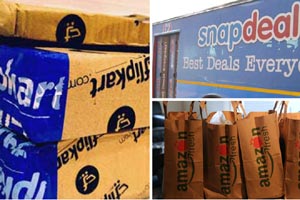Megasales by ecommerce majors like Flipkart, Snapdeal, Amazon in which prices were cut 80% and some top products were available for just Rs 99 are killing festive season, especially Diwali, sales of shopping malls across India. In fact, the festival season this year has triggered a huge rise in online shopping and it may cross the Rs 55,000-crore mark, resulting in the halving of footfalls in malls in places like Delhi, Mumbai, Chennai and Ahmedabad among others.
While online shopping is one big reason, other major factors attributed to this situation include economic slowdown, high interest rates and inflation of consumer goods items. A meager 8-10% of these shopping malls are running successfully in India and facing tough competition from online retailers such as Flipkart, Snapdeal, Amazon, Jabong and others which hand-deliver goods at homes and businesses.
According to a recent survey by industry body ASSOCHAM, Delhi-NCR will see a drop of 55.58% in footfalls, followed by Mumbai (51%), Ahmedabad (49%), Bengaluru (46.5%) and Kolkata (42%) among others. While some malls are operating at 40% occupancy, others struggle with less than 20%, mainly due to poor location, poor design and poor parking facilities, the survey found.
The study also revealed that there may be a five-fold increase in the revenue clocked in by the e-commerce websites in categories such as mobile phones, electronics, designer furniture, home decorations, apparel, accessories, jewellery and footwear among others.
The ASSOCHAM Research team interacted with 3,000 shoppers and also 720 managers, representatives of malls’ management, strategists, marketers and supervisors in Delhi-NCR, Mumbai, Ahmedabad, Bengaluru, Chennai, Kolkata, Hyderabad, Chandigarh and Dehradun.
In nine major cities, more than 59% of the total mall space remains vacant, with Delhi-NCR topping the list with 68.5%, followed by Mumbai at 65%, Ahmedabad at 61% and Bengaluru at 60%. According to the survey, several developers have already started giving rent-free period of up to six months for big brands to lure retailers.
Both retailers and consultants seem convinced that the mall magic seems to have disappeared in a puff of smoke on the back of the economic slowdown, poor revenue model, low footfalls-to-sales conversion and lack of special purpose malls, adds the survey.

